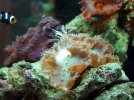Hey all,
First let me thank u guys for the id & links. Been doing a bit of research & decided to setup the 24" i was going to use as a fuge for the elegance to have his own home (it is my fave). Unless maybe have him in the fuge. among the images on the attached link is what i hope to acheive, something similar to that at the waikiki aquarium.
http://www.wetwebmedia.com/elegance.htm
Ok now i have spoken with my LFS & am headin there on saturday. Now I have the tank, the old single tube light & either Sun-Glo 4.2k or Aqua-Glo 18k tubes (all spare stock). Am getting a new heater & was thinking of using just a single powerhead w/canister for filtration, with regular part water changes, or i have an old canister that i could set up for bio filtration, but given wat i have read so far they dont mind the waters being a bit "rich". and prefer minimal flowrates so i dont want to over do it.
Am also getting some "marine sand" it is dry bagged but they say it contains all the essential bacteria etc that become activated when water is added... now this sounds a bit suss to me, have you guys heard about this sort of thing, or is it something you use/have used??
Now i am sure there is something i am forgetting as far as start out, have i missed anything?? Also, how long should i allow it to cycle before adding the grasses? and my elegance? Was thinking of syphoning off the silt from my other tank as part of a water change & use it to help start the new one.. yes / no??
Thanks in advance for any assistance
Camel
First let me thank u guys for the id & links. Been doing a bit of research & decided to setup the 24" i was going to use as a fuge for the elegance to have his own home (it is my fave). Unless maybe have him in the fuge. among the images on the attached link is what i hope to acheive, something similar to that at the waikiki aquarium.
http://www.wetwebmedia.com/elegance.htm
Ok now i have spoken with my LFS & am headin there on saturday. Now I have the tank, the old single tube light & either Sun-Glo 4.2k or Aqua-Glo 18k tubes (all spare stock). Am getting a new heater & was thinking of using just a single powerhead w/canister for filtration, with regular part water changes, or i have an old canister that i could set up for bio filtration, but given wat i have read so far they dont mind the waters being a bit "rich". and prefer minimal flowrates so i dont want to over do it.
Am also getting some "marine sand" it is dry bagged but they say it contains all the essential bacteria etc that become activated when water is added... now this sounds a bit suss to me, have you guys heard about this sort of thing, or is it something you use/have used??
Now i am sure there is something i am forgetting as far as start out, have i missed anything?? Also, how long should i allow it to cycle before adding the grasses? and my elegance? Was thinking of syphoning off the silt from my other tank as part of a water change & use it to help start the new one.. yes / no??
Thanks in advance for any assistance
Camel


